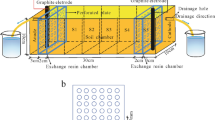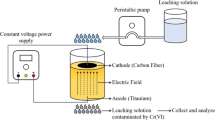Abstract
Disposal of chromium-containing industrial waste has led to soil contamination at dispersed locations around the globe. Considering the carcinogenic, non-biodegradable, and bioaccumulating nature of hexavalent chromium Cr (VI), it is pertinent to treat the contaminated soils. Electrokinetic Remediation (EKR) is a promising technology to remediate metal-contaminated soils under the influence of an electric field. This study investigated the removal of Cr (VI) by EKR, enhanced with a combination of high voltage (50 V), electrolyte conditioning using EDTA (0.1 M), and type of electrode material. Under controlled conditions using distilled water, low voltage (20 V at 1 V/cm) resulted in 22% removal, while high voltage (50 V at 2.5 V/cm) resulted in 55% removal of Cr (VI) in 10 h of treatment period. The removal was further enhanced to 77% by amending with ethylenediaminetetraacetic acid (EDTA 0.1 M) as an electrolyte at a high voltage gradient of 2.5 V/cm. Classifying the role of electrode (graphite and stainless steel), based on the removal efficiency and corrosion of electrodes, graphite resulted in higher removal compared to stainless steel but with a significantly higher corrosion effect. Characterization of soil after EKR experiments exhibited improved liquid and plastic limits, and insignificant difference in Total Organic Carbon (TOC) and other parameters related to soil health. Energy consumption and cost-estimation revealed that application of high voltage, along with conditioning of electrolyte with EDTA can significantly increase removal of Cr (VI) in short period of time in a cost-effective (0.8 US$/g) way, thereby can be applied for rapid treatment of large volumes of soil without affecting the properties of soil.
Graphical abstract







Similar content being viewed by others
Data availability
All data generated or analysed during this study are included in this published article.
References
Acar YB, Alshawabkeh AN (1993) Principles of electrokinetic remediation. Environ Sci Technol 27(13):2638–2647. https://doi.org/10.1021/ES00049A002
Acar YB, Alshawabkeh AN, Gale RJ (1993) Fundamentals of extracting species from soils by electrokinetics. Waste Manag 13(2):141–151. https://doi.org/10.1016/0956-053X(93)90006-I
Al-Hamdan AZ, Reddy KR (2008) Transient behavior of heavy metals in soils during electrokinetic remediation. Chemosphere 71(5):860–871. https://doi.org/10.1016/j.chemosphere.2007.11.028
APHA (1992a) Method 3111. Standard methods for the examination of water and wastewater, 19th edn. American Public Health Association, Washington
APHA (1992b) Method 3500-CR. Standard methods for the examination of water and wastewater, 19th edn. American Public Health Association, Washington
Apte AD, Tare V, Bose P (2006) Extent of oxidation of Cr(III) to Cr(VI) under various conditions pertaining to natural environment. J Hazard Mater 128(2–3):164–174. https://doi.org/10.1016/J.JHAZMAT.2005.07.057
ASTM (2007) Standard test method for particle-size analysis of soils. ASTM D422. ASTM, West Conshohocken
ASTM (2014a) Standard test methods for specific gravity of soil solids by water pycnometer. ASTM D854. ASTM, West Conshohocken
ASTM (2014b) Standard test methods for moisture, ash, and organic matter of peat and other organic soils. ASTM D2974. ASTM, West Conshohocken
ASTM (2014c) Standard test method for rapid determination of carbonate content of soils. ASTM D4373. ASTM, West Conshohocken
ASTM (2017) Standard test methods for liquid limit, plastic limit, and plasticity index of soils. ASTM D4318. ASTM, West Conshohocken
ASTM (2019) Standard test methods for pH of soils. ASTM D4972. ASTM, West Conshohocken
Bekkouche MS, Bessaim MM, Maliki M, Missoum H, Bendani K, Laredj N (2020) Enhanced electrokinetic removal of problematic salts in arid and semi-arid areas. Euro-Mediterr J Environ Integr 5(1):1–8. https://doi.org/10.1007/S41207-020-0142-9
Benamar A, Baraud F (2011) Electrokinetic remediation of dredged sediments from Le Havre Harbour. Eur J Environ Civil Eng 15(2):215–228
Bessaim MM, Karaca O, Missoum H, Bendani K, Laredj N, Bekkouche MS (2020) Effect of imposed electrical gradient on removal of toxic salt contaminants from alkali-saline low permeable soil during electrokinetic remediation. Arab J Geosci 13(14):1–12
Cameselle C, Gouveia S (2020) Removal of multiple metallic species from sludge by electromigration. J Hazard Toxic Radioact Waste 24(1):04019030. https://doi.org/10.1061/(asce)hz.2153-5515.0000470
Cameselle C, Pena A (2016) Enhanced electromigration and electro-osmosis for the remediation of an agricultural soil contaminated with multiple heavy metals. Process Saf Environ Prot 104:209–217. https://doi.org/10.1016/j.psep.2016.09.002
Cameselle C, Gouveia S, Cabo A (2021) Enhanced electrokinetic remediation for the removal of heavy metals from contaminated soils. Appl Sci. https://doi.org/10.3390/app11041799
Figueroa A, Cameselle C, Gouveia S, Hansen HK (2016) Electrokinetic treatment of an agricultural soil contaminated with heavy metals. J Environ Sci Health Part A 51(9):691–700. https://doi.org/10.1080/10934529.2016.1170425
Gao M, Zeng F, Tang F, Wang K, Xu X, Tian G (2020) An increasing Cr recovery from soil with catholyte-enhanced electrokinetic remediation: effects on voltage redistribution throughout soil sections. Sep Purif Technol 253:117553
Gidudu B, Chirwa EM (2020) The combined application of a high voltage, low electrode spacing, and biosurfactants enhances the bio-electrokinetic remediation of petroleum contaminated soil. J Clean Prod 276:122745
Johar MS, Embong Z (2015) The optimisation of electrokinetic remediation for heavy metals and radioactivity contamination on Holyrood-Lunas soil (acrisol species) in Sri Gading Industrial Area, Batu Pahat, Johor Malaysia. Radiat Prot Dosim 167(1–3):160–164. https://doi.org/10.1093/rpd/ncv236
Karaca O, Cameselle C, Reddy KR (2017) Acid Pond sediment and mine tailings contaminated with metals: physicochemical characterization and electrokinetic remediation. Environ Earth Sci 76(12):1–12
Karaca O, Cameselle C, Bozcu M (2019) Opportunities of electrokinetics for the remediation of mining sites in Biga peninsula, Turkey. Chemosphere 227:606–613
Karaca O, Karaca G, Cameselle C, Karaca I (2022) Removal of the pesticides from soil using electrokinetic method. Rend Fis Acc Lincei 33(3):623–629
Li X, Yang Z, He X, Liu Y (2020) Optimization analysis and mechanism exploration on the removal of cadmium from contaminated soil by electrokinetic remediation. Sep Purif Technol 250:117180
Liang J, Huang X, Yan J, Li Y, Zhao Z, Liu Y, Ye J, Wei Y (2021) A review of the formation of Cr(VI) via Cr(III) oxidation in soils and groundwater. Sci Tot Environ 774:145762. https://doi.org/10.1016/J.SCITOTENV.2021.145762
Lu N, Li D, Yu X, Muhammad F, Yan Y, Yu L, Li H, Huang X, Jiao B (2019) Effect of chemical additives on electrokinetic remediation of Cr-contaminated soil coupled with a permeable reactive barrier. R Soc Open Sci 6(5):1138. https://doi.org/10.1098/rsos.182138
Ma C, Li J, Xia W, Ding Y, Zhang L, Xu Y (2022) Effect of additives on the remediation of arsenic and chromium co-contaminated soil by an electrokinetic-permeable reactive barrier. Environ Sci Pollut Res 29(8):11966–11975
Nasiri A, Jamshidi-Zanjani A, Khodadadi Darban A (2020) Application of enhanced electrokinetic approach to remediate Cr-contaminated soil: effect of chelating agents and permeable reactive barrier. Environ Pollut 266:115197. https://doi.org/10.1016/J.ENVPOL.2020.115197
Oliveira H (2012) Chromium as an environmental pollutant: insights on induced plant toxicity. J Bot. https://doi.org/10.1155/2012/375843
Prakash P, Sonal S, Mishra BK (2022) Transportation mechanism of chromium from tannery sludge through an electrokinetic process: role of electrolytes and operational conditions. Int J Environ Sci Technol 19(5):3757–3772. https://doi.org/10.1007/S13762-021-03278-2/TABLES/7
Prasad S, Yadav KK, Kumar S, Gupta N, Cabral-Pinto MMS, Rezania S, Radwan N, Alam J (2021) Chromium contamination and effect on environmental health and its remediation: a sustainable approaches. J Environ Manag 285:112174. https://doi.org/10.1016/J.JENVMAN.2021.112174
Reddy KR, Cameselle C (2009) Electrochemical remediation technologies for polluted soils sediments and groundwater. John Wiley. https://doi.org/10.1002/9780470523650
Reddy KR, Chinthamreddy S (2004) Enhanced Electrokinetic Remediation of Heavy Metals in Glacial Till Soils Using Different Electrolyte Solutions. J Environ Eng 130(4):442–455. https://doi.org/10.1061/(asce)0733-9372(2004)130:4(442)
Reddy KR, Karri MR (2006) Effect of voltage gradient on integrated electrochemical remediation of contaminant mixtures. Land Contam Reclam. https://doi.org/10.2462/09670513.786
Reddy KR, Parupudi US, Devulapalli SN, Xu CY (1997) Effects of soil composition on the removal of chromium by electrokinetics. J Hazard Mater 55(1–3):135–158. https://doi.org/10.1016/S0304-3894(97)00020-4
Saleem M, Chakrabarti MH, Irfan MF, Hajimolana SA, Hussain MA, Diya’uddeen BH, Daud WMAW, (2011) Electrokinetic remediation of nickel from low permeability soil. Int J Electrochem Sci 6(9):4264–4275
Shin SY, Park SM, Baek K (2017) Soil moisture could enhance electrokinetic remediation of arsenic-contaminated soil. Environ Sci Pollut Res 24(10):9820–9825. https://doi.org/10.1007/s11356-017-8720-3
Song Y, Ammami MT, Benamar A, Mezazigh S, Wang H (2016) Effect of EDTA, EDDS, NTA and citric acid on electrokinetic remediation of As, Cd, Cr, Cu, Ni, Pb and Zn contaminated dredged marine sediment. Environ Sci Pollut Res 23(11):10577–10586. https://doi.org/10.1007/s11356-015-5966-5
Sun R, Gong W, Chen Y, Hong J, Wang Y (2021) Influence of polarity exchange frequency on electrokinetic remediation of Cr-contaminated soil using DC and solar energy. Process Saf Environ Prot 153:117–129. https://doi.org/10.1016/J.PSEP.2021.07.008
USEPA (1992) Test methods for evaluating solid waste, physical/chemical methods, 3rd edn. USEPA, Washington, p SW-846
Virkutyte J, Sillanpää M, Latostenmaa P (2002) Electrokinetic soil remediation - critical overview. Sci Total Environ 289(1–3):97–121. https://doi.org/10.1016/S0048-9697(01)01027-0
Wei Y, Sun B, Hui Z, Li S (2011) Experimental study on electrokinetic remediation of in-situ Cd contaminated soil by applied voltage. ICMREE Proc Int Conf Mater Renew Energy Environ. https://doi.org/10.1109/ICMREE.2011.5930701
Wu J, Zhang J, Xiao C (2016) Focus on factors affecting pH, flow of Cr and transformation between Cr (VI) and Cr (III) in the soil with different electrolytes. Electrochim Acta 211:652–662
Wu J, Wei B, Lv Z, Fu Y (2021) To improve the performance of focusing phenomenon related to energy consumption and removal efficiency in electrokinetic remediation of Cr-contaminated soil. Sep Purif Technol 272:118882. https://doi.org/10.1016/J.SEPPUR.2021.118882
Acknowledgements
The authors acknowledge the help of lab technicians of Delhi Technological University during the study.
Funding
No funding was received for this study.
Author information
Authors and Affiliations
Corresponding author
Ethics declarations
Conflict of interest
The authors declare that they have no conflict of interests.
Ethical approval and consent to participate
Not applicable.
Consent to participate
Not applicable.
Consent for publication
Not applicable.
Additional information
Publisher's Note
Springer Nature remains neutral with regard to jurisdictional claims in published maps and institutional affiliations.
Rights and permissions
Springer Nature or its licensor (e.g. a society or other partner) holds exclusive rights to this article under a publishing agreement with the author(s) or other rightsholder(s); author self-archiving of the accepted manuscript version of this article is solely governed by the terms of such publishing agreement and applicable law.
About this article
Cite this article
Taneja, S., Karaca, O. & Haritash, A.K. Combined effects of high voltage gradient and electrolyte conditioning on electrokinetic remediation for chromium (VI)-contaminated soils. Rend. Fis. Acc. Lincei 34, 635–646 (2023). https://doi.org/10.1007/s12210-023-01159-z
Received:
Accepted:
Published:
Issue Date:
DOI: https://doi.org/10.1007/s12210-023-01159-z




